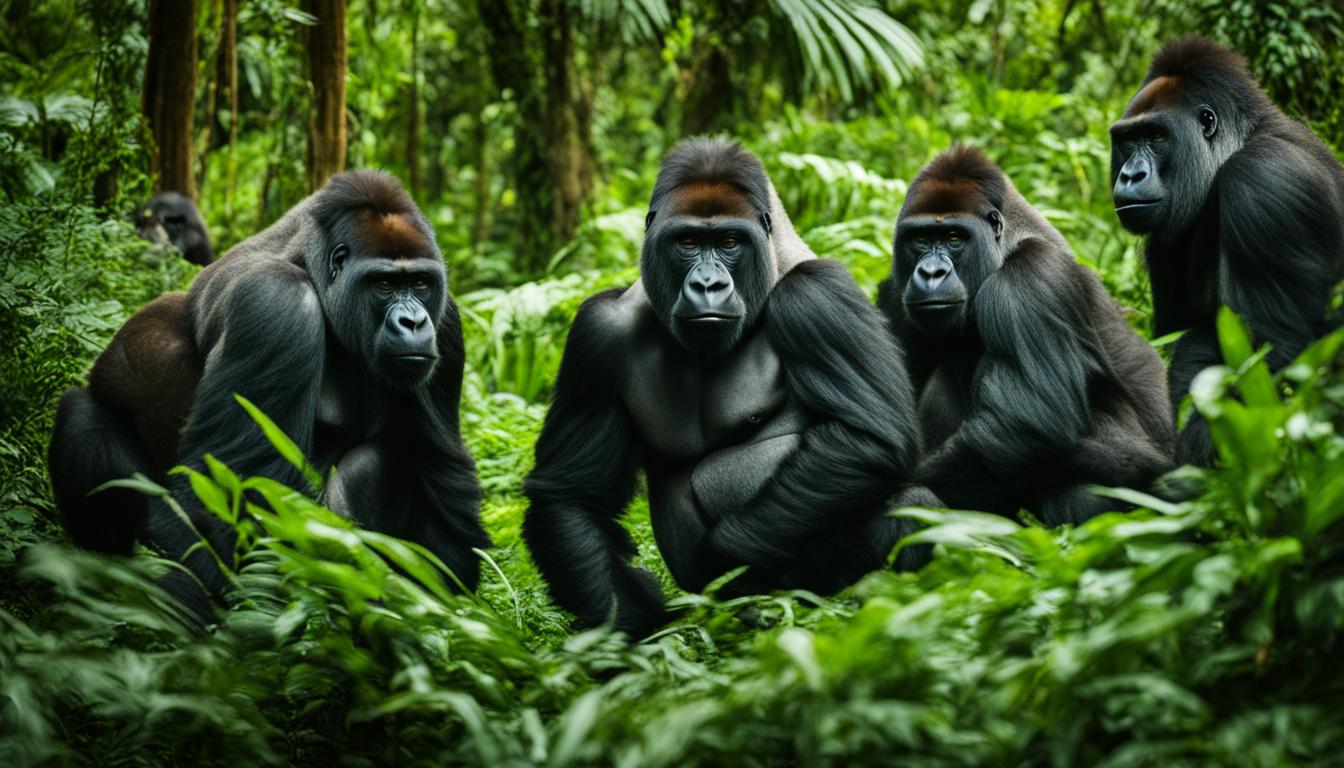Gorillas in the wild have a fascinating system of communication that involves both verbal and nonverbal forms. From grunts and grumbles to visual cues and gestures, these primates have developed a unique language of their own. Understanding gorilla communication provides valuable insights into their social dynamics and behavior.
Verbal communication in gorillas
Gorillas use vocalizations as a means of verbal communication within their social groups. These vocalizations include grunts and grumbles, each serving different purposes. Grunts are short, expressive sounds that convey positive emotions, often associated with the presence of favorite foods or social interactions. Grumbles, on the other hand, are longer and more varied in tone and pitch. They serve as positive expressions, comfort vocalizations, and a way for gorillas to share their location with others.
Young gorillas also use vocalizations to attract the attention of their mothers. Whimpers, cries, and screams can be heard when they seek maternal care or when they are in distress. These vocalizations play an important role in maintaining social bonds within the gorilla group.
Overall, vocal communication is a crucial component of gorilla interaction and allows individuals to convey their emotions, share information about their well-being and whereabouts, and contribute to the cohesion of the group.
Table: Comparison of Gorilla Vocalizations
| Vocalization | Purpose |
|---|---|
| Grunts | Convey positive emotions, indicate the presence of favorite foods, and accompany social interactions |
| Grumbles | Longer vocalizations that serve as positive expressions, comfort vocalizations, and a way to share location with other gorillas |
| Whimpers, cries, and screams | Used by young gorillas to attract the attention of their mothers or signal distress |
Table: Comparison of gorilla vocalizations and their purposes
Nonverbal communication in gorillas
Gorillas rely heavily on nonverbal communication, using gestures, postures, and visual cues to convey information and maintain social bonds within their groups. These nonverbal forms of communication play a vital role in the complex social dynamics of gorilla communities.
Gorilla gestures are a key aspect of their communication repertoire. They use a variety of hand and arm movements to signal their intentions or to prompt other gorillas to engage in specific behaviors. For example, a gorilla may extend an open hand to initiate play or raise both arms in a display of dominance or threat. Gestures provide a means of expressing social cues and facilitating interactions.
Postures also play a crucial role in gorilla communication. Chest-puffing, where a gorilla inflates its chest and stands upright, is a common posture used to assert dominance. Gorillas may also use submissive postures, such as crouching or lying down, to show deference to more dominant individuals. These postures help establish and maintain the hierarchical structure within the group.
Visual cues, such as side-eye glances, are another important element of gorilla communication. Gorillas use these glances to monitor the behavior of others in the group and gather information about their intentions. These visual cues assist in maintaining social cohesion and regulating group interactions.
| Gorilla Gestures | Gorilla Postures | Gorilla Visual Cues |
|---|---|---|
| Hand and arm movements | Chest-puffing | Side-eye glances |
| Used to signal intentions | Establish dominance | Monitor behavior |
| Facilitate interactions | Show deference | Maintain social cohesion |
Understanding nonverbal communication in gorillas provides valuable insights into their social lives and sheds light on their complex social dynamics. Through gestures, postures, and visual cues, gorillas navigate their social hierarchy, establish relationships, and communicate important information, contributing to the cohesion and stability of their communities.

As we delve deeper into the world of gorilla communication, it becomes evident that these magnificent creatures possess a sophisticated language of their own. By studying their nonverbal cues, gestures, and postures, we gain a deeper understanding of their social structure and the intricate web of relationships that exist within gorilla groups. So next time you observe a troop of gorillas, pay attention to their nonverbal communication – you may be witnessing a fascinating display of social interaction and connection.
Gorilla Communication Methods and Senses
Gorillas communicate using a variety of methods that combine vocalizations, visual cues, gestures, and body language. Research and studies have been conducted to gain insight into the complexity of gorilla communication. One fascinating aspect of their communication is the use of vocalizations, with gorillas known to make at least 22 distinct sounds to convey different feelings and situations. These vocalizations include grunts, grumbles, and screams, each serving a specific purpose in conveying emotions or sharing information.
Aside from vocalizations, gorillas also rely on their senses of touch and smell to communicate with each other. For example, silverback males have a distinct smell that identifies them and alerts the group to potential danger. They can also emit specific scents in dangerous situations to alarm and communicate with the rest of the group. This reliance on multiple senses adds complexity and depth to the communication methods used by gorillas.
Further research and studies continue to shed light on gorilla communication, helping us better understand the intricacies of their social interactions and behaviors. By delving into the world of gorilla communication, scientists and researchers gain valuable insights into the lives of these magnificent creatures and the significance of their communication methods in maintaining social bonds and group cohesion.
| Communication Method | Description |
|---|---|
| Vocalizations | Gorillas use a range of vocalizations, including grunts, grumbles, screams, and whimpering, to convey emotions, share information, and attract attention. |
| Visual Cues | Gorillas communicate through body postures, facial expressions, and side-eye glances, indicating their mood, intentions, and keeping tabs on other individuals in the group. |
| Gestures and Body Language | Postures, such as chest-puffing or beating, are used to display dominance or threat. Gorillas also engage in play to reinforce social bonds and communicate with others. |
| Touch and Smell | Gorillas use touch and smell to communicate with conspecifics. They rely on their sense of smell to identify individuals and emit specific scents in dangerous situations to alarm the group. |
Quote:
“Gorillas have a fascinating system of communication that includes both verbal and nonverbal forms. Through vocalizations, gestures, and body language, gorillas convey their emotions, share information, and maintain social bonds.” – Gorilla Communication Researcher
Gorilla Social Structure and Dynamics
Gorillas have a complex social structure that is both fluid and dynamic. At the head of the group is the dominant silverback male, who serves as the leader and protector of the family. The silverback makes important decisions for the group and ensures their safety and well-being. Surrounding the silverback are adult females, subordinate silverbacks, younger males (blackbacks), juveniles, and infants.
The hierarchy within the gorilla group can shift based on various factors. For example, the position of females in the hierarchy may change during pregnancy or when caring for a baby. The support of the females is crucial for the silverback’s power and influence. Conflict resolution and mediation also play a role in maintaining group cohesion and harmony.
Gorilla social dynamics involve complex relationships and politics. The interactions between individuals are influenced by factors like dominance, threat displays, and play behavior. Through these interactions, gorillas establish and reinforce social bonds, which are vital for their well-being and survival as a group. Understanding the social structure and dynamics of gorillas helps us gain insight into their fascinating lives and provides valuable knowledge for their conservation.
| Gorilla Social Structure | Gorilla Group Dynamics |
|---|---|
| 1. Dominant silverback male | 1. Shifting hierarchy based on factors like pregnancy and presence of babies |
| 2. Adult females | 2. Support of females essential for silverback’s power |
| 3. Subordinate silverbacks | 3. Conflict resolution and mediation for group cohesion |
| 4. Younger males (blackbacks) | 4. Complex relationships and politics |
| 5. Juveniles | 5. Social bonds established through interactions |
| 6. Infants | 6. Insight into gorilla lives for conservation |
Understanding the social structure and dynamics of gorillas provides a deeper appreciation for their intricate social lives. It also highlights the importance of protecting their natural habitats and maintaining their populations in the wild. By preserving the social fabric of gorilla communities, we can contribute to the long-term survival of these magnificent creatures.
Conclusion
Understanding gorilla communication is a fascinating journey into the complex social lives of these majestic creatures. Gorillas employ both verbal and nonverbal forms of communication to convey their emotions, share information, and maintain social bonds.
Through vocalizations such as grunts and grumbles, gorillas express positive emotions, share their location, and accompany social interactions within the group. Nonverbal communication, including gestures, body language, and visual cues, plays a significant role in their interactions. Postures, facial expressions, and play behaviors are used to display dominance, communicate intentions, and reinforce social bonds.
In addition to their senses of hearing and seeing, gorillas also rely on touch and smell to communicate with their conspecifics. Gorillas use touch to reinforce social bonds and emit specific scents in dangerous situations to alarm the group. Their communication methods involve a combination of senses that enhance their social interactions.
Overall, studying gorilla communication provides valuable insights into the intricacies of their social structure and dynamics. From the dominant silverback leading the group to the shifting hierarchy influenced by factors such as pregnancy and the presence of babies, gorilla social lives are filled with complex relationships and politics. By unraveling the mysteries of their communication system, we gain a deeper appreciation for these remarkable creatures and their remarkable ways of connecting with one another.
Do Gorillas Use Different Communication Methods to Form Bonds with Siblings?
Gorillas form strong bonds through various communication methods with their siblings. Utilizing vocalizations, grooming, and gentle physical interactions, gorilla sibling interactions and bonds are established and reinforced. These connections are crucial for social cohesion within the group and play a vital role in their overall well-being.
FAQ
How do gorillas communicate with each other in the wild?
Gorillas in the wild communicate through verbal and nonverbal forms of communication, including vocalizations, gestures, body language, visual cues, touch, and smell.
What are some examples of verbal communication in gorillas?
Gorillas use grunts and grumbles to express positive emotions, share their location, and accompany social interactions. Young gorillas may whimper, cry, or scream to attract their mother’s attention.
How do gorillas communicate nonverbally?
Gorillas communicate nonverbally through body postures, facial expressions, visual cues like side-eye glances, and play behaviors. These forms of communication indicate mood, intentions, dominance, threat, and reinforce social bonds.
What methods and senses do gorillas use for communication?
Gorillas use a combination of vocalizations, gestures, body language, visual cues, touch, and smell for communication purposes. They have been known to make at least 22 distinct sounds to convey different feelings and situations.
How does gorilla social structure work?
Gorilla social structure is dynamic, with a dominant silverback leading the group. The hierarchy can shift based on factors like pregnancy and the presence of babies. Conflict resolution and mediation play a role in maintaining group cohesion.
What can we learn from studying gorilla communication?
Studying gorilla communication provides insights into their complex social lives and helps us better understand these majestic creatures. It helps us understand the richness of primate communication and the importance of nonverbal cues in social interactions.










